Nonstick pans aren’t the most famous piece of kitchenware in your home (that honor goes to cast iron), but they serve a vital role.
Nonstick pans have revolutionized how many of us cook, offering ease of use and minimal cleaning fuss. But like all cookware, they have specific guidelines for optimal use. One of these is avoiding high heat.
Food doesn’t stick to nonstick pans due to their highly distinctive coating. Teflon, generally called Polytetrafluoroethylene (PTFE), has been employed to prevent food adhesion since the 1940s. Nonstick coatings are placed on aluminum, stainless steel, and cast iron cookware before the completed surface is heated to exceptionally high temperatures.
When nonstick Cookware is overheated, the coating breaks away, enabling surface particles and hazardous gases to escape. That is why using a nonstick pan on high heat is not ideal.
Home chefs are frequently anxious about nonstick Cookware, wondering if the chemicals employed in its production would be absorbed into their food or discharged into the air, eventually ending up in their bodies.
1. Preserving the Nonstick Feature
Coating Care: The unique feature of these pans is their nonstick coating. Using them on high heat can lead to this layer’s quicker wear and tear.

When the nonstick surface begins to deteriorate, you might use more oils or fats to prevent sticking, which can counteract the health benefits of using such pans.
2. Safety Concerns
Avoiding Toxins: Some nonstick pans, especially those made with Teflon (or PTFE), can release harmful chemicals when exposed to high temperatures.
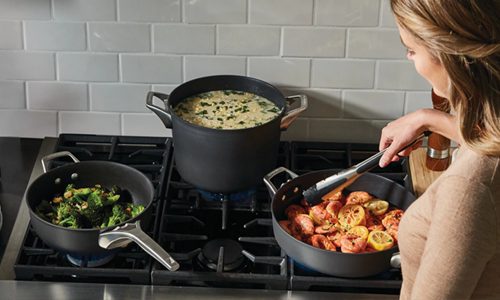
Breathing in these fumes isn’t just unpleasant – it can harm your health.
3. Taste and Texture
Even Cooking: High heat can result in uneven cooking. Your dish might end up with a burnt exterior while remaining undercooked inside.
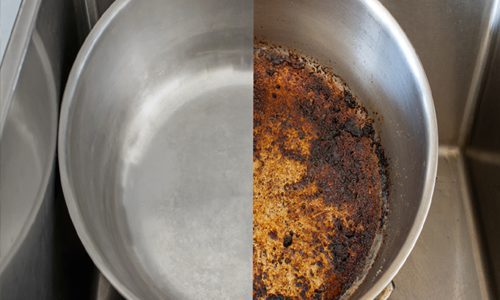
This alters the taste and can make your meal less appealing in terms of texture and presentation.
4. Longevity of Your Pan
Avoiding Warps: Subjecting your nonstick pans to high heat can warp the base. Once a pan is warped, it doesn’t sit flat on the burner, leading to uneven heat distribution and ultimately, an inefficient cooking experience.
5. Nutrient Retention
Optimal Nutrition: Cooking on a raging high flame can strip away essential nutrients from some foods.
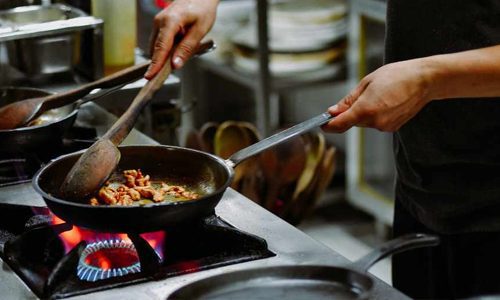
Retaining the maximum nutritional value often requires gentle cooking, something which nonstick pans on low to medium heat are perfectly designed for.
Tips And Alternatives For Using Calphalon Cookware
For cooking safely, using Calphalon Nonstick Cookware does not exceed the temperatures advised by Calphalon, which range from 400 to 500xb0F. Calphalon nonstick cookware should not be used in the broiler. Use low to medium Heat on the burner instead of high (enough to sear the meat).
Cast iron, stainless steel, and carbon steel are all suitable high-temperature cooking materials, but each has advantages and downsides. Either cast iron for maximum heat retention, alloy steel for simple cleaning, or carbon steel for a middle-of-the-road option.
Do’s And Don’ts For Cooking With Nonstick Cookware
- Always ensure that there is food or water in your pans or saucepans before heating them up, and avoid cooking over high heat to prevent broiling, which requires higher temperatures than recommended for nonstick cookware.
- Remember to ventilate your kitchen.
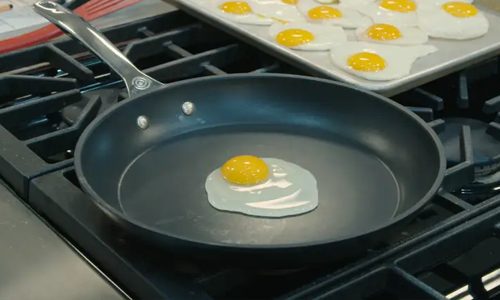
- When using a nonstick pan, it’s best to use wooden spoons or silicone spatulas instead of metal utensils or steel wool, as these can scratch or chip the coating and damage the pan.
- Additionally, avoid using cooking spray on nonstick cookware, as it can create a residue buildup that is difficult to remove and may damage the pan. Instead, opt for cooking fats like butter or olive oil.
How to Wash & Clean Nonstick Pans?
Dishwashers are safe for glass, enamelware, and stainless steel. All other Cookware, especially nonstick, should be hand-cleaned.
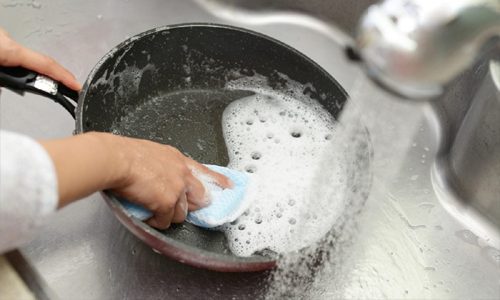
While most nonstick Cookware is labeled “dishwasher safe,” the temperature from the dishwasher and cleansers can cause the coating to erode over time. Instead, take a few additional minutes to hand-wash your nonstick pan.
FAQs
Can I use a nonstick pan on high Heat?
Using a nonstick pan on high Heat is not recommended. Nonstick pans are designed for low to medium heat settings, as high Heat can damage the nonstick coating and release harmful fumes.
What happens if I use a nonstick pan on high Heat?
When a nonstick pan is used on high Heat, the coating can break down and release toxic fumes, including perfluorooctanoic acid (PFOA) and other chemicals that can be harmful to humans and pets. The fumes can cause flu-like symptoms, including headache, fever, and chills.
How can I tell if my nonstick pan is damaged?
Signs of damage to a nonstick pan include peeling or flaking of the coating, scratches, or discoloration. If you notice any of these signs, it’s time to replace your pan.
What should I use instead of a nonstick pan for high-heat cooking?
For high-heat cooking, it’s best to use a cast iron, stainless steel, or carbon steel pan. These types of pans can withstand high temperatures and provide excellent heat distribution.
How can I care for my nonstick pan to prolong its lifespan?
To maintain your nonstick pan, avoid using metal utensils, abrasive sponges, or harsh chemicals that can cause scratches or harm the coating. Instead, use silicone or wooden utensils and clean the pan using warm, soapy water and a soft sponge. Avoid soaking the pan for extended periods or using the dishwasher for cleaning.
Is using a nonstick pan at low to medium heat safe?
Yes, using a nonstick pan at low to medium heat settings is safe as long as the pan is in good condition and not damaged. Always follow the manufacturer’s instructions for using and caring for your nonstick pan.
Conclusion
Folks, hope you got your answer for why using a nonstick pan on high heat isn’t ideal. Proper care of nonstick pans, including avoiding harsh chemicals and abrasive sponges, can help prolong their lifespan!